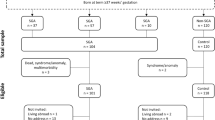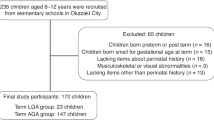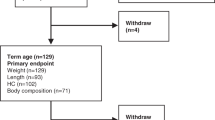Abstract
OBJECTIVE: To assess the effect of daily movements on weight gain, serum leptin, and insulin-like growth factor I (IGF-I) in premature infants.
STUDY DESIGN: Twenty very-low-birth-weight premature infants were matched and randomized to a daily movement (n=10) and control groups (n=10). Daily movement consisted of passive range of motion with gentle compression of both the upper and lower extremities 5 days per week for 4 weeks.
RESULTS: Daily movements led to a significant increase in weight gain (784±51 vs 608±26 g in movements and controls, respectively, p<0.02), and to a significant increase in leptin (0.60±0.19 vs 0.13±0.06 ng/ml in movements and controls, respectively, p<0.05). Changes in body weight correlated with changes in serum leptin (r=0.48, p<0.03). IGF-I also increased following daily movements (18.8±4.1 vs 9.2±4.1 ng/ml in movements and controls, respectively); however, this increase was not statistically significant.
CONCLUSION: A relatively brief range of motion daily movement intervention was associated with greater weight gain and increased leptin levels in very-low-birth-weight premature infants. This may suggest that at least part of the daily movements associated with increase in body weight resulted from an increase in adipose tissue.
This is a preview of subscription content, access via your institution
Access options
Subscribe to this journal
Receive 12 print issues and online access
$259.00 per year
only $21.58 per issue
Buy this article
- Purchase on SpringerLink
- Instant access to full article PDF
Prices may be subject to local taxes which are calculated during checkout

Similar content being viewed by others
References
Zhang Y, Proenca R, Maffei M, Barone M, Leopold L, Friedman JM . Positional cloning of the mouse obese gene and its human homologue Nature 1994 372: 425–32
Considine RV . Regulation of leptin production Rev Endocrinol Metab Dis 2001 2: 357–63
Considine RV, Sinha M, Heiman ML et al. Serum immuno-reactive leptin concentration in normal weight and obese humans N Engl J Med 1996 334: 292–5
Hassink SG, Sheslow DV, de Lancey E, Opentanova I, Considine RV, Caro JF . Serum leptin in children with obesity: relationship to gender and development Pediatrics 1996 98: 201–3
Wiznitzer A, Furman B, ZuiliI B, Shany S, Reece A, Mazor M . Cord leptin level and fetal macrosomia Obstet Gynecol 2000 96: 707–13
Matsuda J, Yokota I, Iida M et al. Serum leptin concentration in cord blood: relationship to birth weight and gender J Clin Endocrinol Metab 1997 82: 1642–4
Wolf HJ, Ebenbichler CF, Huter O et al. Fetal leptin and insulin levels only correlate in large for gestational age infants Eur J Endocrinol 2000 142: 623–9
Gomez L, Carrascosa A, Yeste D et al. Leptin values in placental cord blood of human newborns with normal intra-uterine growth after 30–42 weeks of gestation Horm Res 1999 51: 10–4
Matsuda J, Yokota I, Iida M et al. Dynamic changes in serum leptin concentration during the fetal and neonatal periods Pediatr Res 1999 45: 71–5
Harigaya A, Onogata K, Nako Y, Nagashima K, Morikawa A . Role of serum leptin in the regulation of weight gain in early infancy Biol Neonat 1999 75: 234–8
Ng PC, Lam CWK, Lee CH et al. Changes of leptin and metabolic hormones in premature infants: a longitudinal study in early postnatal life Clin Endocrinol 2001 54: 673–80
Spear ML, Hassink SG, Leef K et al. Immaturity or starvation? Longitudinal study of leptin levels in premature infants Biol Neonat 2001 80: 35–40
Moyer-Mileur LJ, Leutkemeier M, Boomer L, Chan GM . Effect of physical activity on bone mineralization in premature infants J Pediatr 1995 127: 620–5
Moyer-Mileur LJ, Brunstetter V, McNaught TP, Gill G, Chan GM . Daily physical activity program increases bone mineralization and growth in preterm very low birth weight infants Pediatrics 2000 106: 1088–92
Nemet D, Dolfin T, Litmanowitz I, Shainkin-Kestenbaum R, Lis M, Eliakim A . Evidence for exercise-induced bone formation in premature infants Int J Sports Med 2002 23: 82–5
Reseland JE, Syversen U, Bakke I et al. Leptin is expressed in and secreted from primary cultures of human osteoblasts and promotes bone mineralization J Bone Miner Res 2001 16: 1426–33
Kume K, Satomura K, Nishisho S et al. Potential role of leptin in endochondral ossification J Histochem Cytochem 2002 50: 159–69
Klauwer D, Blum WF, Hanitsch S, Rascher W, Lee PD, Kiess W . IGF-I, IGF-II, free IGF-I and IGFBP-1, -2, and -3 levels in venous cord blood: relationship to birth weight, length, and gestational age in healthy newborns Acta Pediatr 1997 86: 826–33
Eliakim A, Brasel JA, Mohan S, Barstow TJ, Berman N, Cooper DM . Physical fitness, endurance training, and the GH–IGF-I system in adolescent females J Clin Endocrinol Metab 1996 81: 3986–92
Poehlman ET, Copeland KC . Influence of physical activity on insulin-like growth factor I in healthy younger and older men J Clin Endocrinol Metab 1990 71: 1468–73
Resto M, O'Connor D, Leef K, Funanage V, Spear M, Locke R . Leptin levels in preterm human breast milk and infant formula Pediatrics 2001 108: E15
Gutin B, Ramsey L, Barbeau P et al. Plasma leptin concentration in obese children: changes during 4-mo period with and without physical training Am J Clin Nutr 1999 69: 388–94
Perusse L, Collier G, Gagnon J et al. Acute and chronic effects of exercise on leptin levels in humans Am J Physiol 1997 83: 5–10
Hickey MS, Houmard JA, Considine RV et al. Gender-dependent effects of exercise training on serum leptin levels in humans Am J Physiol 1997 274: E562–6
Pasman WJ, Westerterp-Plantenga MS, Saris WHM . The effect of exercise training on leptin levels in obese males Am J Physiol 1998 274: E280–6
Thong FS, Hudson R, Ross R, Janssen I, Graham TE . Plasma leptin in moderately obese men: Independent effects of weight loss and aerobic exercise Am J Physiol 2000 279: E307–13
Eliakim A, Brasel JA, Mohan S, Wong WLT, Cooper DM . Increased physical activity and the growth hormone–IGF-I axis in adolescent males Am J Physiol 1998 275: R308–14
Falk B, Eliakim A, Dotan R, Liebermann DG, Regev R, Bar-Or O . Birth weight and physical ability in 5 to 8 yr old healthy children born prematurely Med Sci Sports Exerc 1997 29: 1124–30
Acknowledgements
We thank MaryAnn Hill, PhD, from the University of California, Irvine, CA, USA, for her help in performing the statistical analysis.
Author information
Authors and Affiliations
Additional information
Biostatistics consult: MaryAnn Hill, PhD, Biostatistician, University of California, Irvine, CA 92868, USA.
Rights and permissions
About this article
Cite this article
Eliakim, A., Dolfin, T., Weiss, E. et al. The Effects of Exercise on Body Weight and Circulating Leptin in Premature Infants. J Perinatol 22, 550–554 (2002). https://doi.org/10.1038/sj.jp.7210788
Published:
Issue Date:
DOI: https://doi.org/10.1038/sj.jp.7210788
This article is cited by
-
Effect of physiotherapy on the promotion of bone mineralization in preterm infants: a randomized controlled trial
Scientific Reports (2022)
-
Effect of physical therapy on bone remodelling in preterm infants: a multicenter randomized controlled clinical trial
BMC Pediatrics (2022)
-
Passive movement and active exercise for very young infants with congenital heart disease: a study protocol for a randomized controlled trial
Trials (2015)
-
Early developmental care interventions of preterm very low birth weight infants
Indian Pediatrics (2013)
-
Bone ultrasound velocity in small- versus appropriate-for-gestational age preterm infants
Journal of Perinatology (2007)



